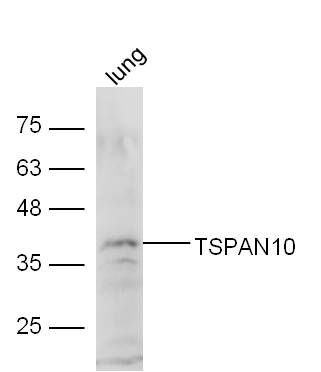产品货号 : mlR9419
英文名称 : TSPAN10
中文名称 : 四分子交联体10抗体(四旋蛋白)
别 名 : OCSP; oculospanin; tetraspanin 10; Tspan 10; TSN10_HUMAN.
研究领域 : 肿瘤 细胞生物 神经生物学 细胞分化
抗体来源 : Rabbit
克隆类型 : Polyclonal
交叉反应 : Human, Mouse, Rat,
产品应用 : ELISA=1:500-1000 IHC-P=1:400-800 IHC-F=1:400-800 IF=1:50-200 (石蜡切片需做抗原修复)
not yet tested in other applications.
optimal dilutions/concentrations should be determined by the end user.
分 子 量 : 36kDa
细胞定位 : 细胞膜
性 状 : Lyophilized or Liquid
浓 度 : 1mg/ml
免 疫 原 : KLH conjugated synthetic peptide derived from human TSPAN10/Oculospanin:181-280/355
亚 型 : IgG
纯化方法 : affinity purified by Protein A
储 存 液 : 0.01M TBS(pH7.4) with 1% BSA, 0.03% Proclin300 and 50% Glycerol.
保存条件 : Store at -20 °C for one year. Avoid repeated freeze/thaw cycles. The lyophilized antibody is stable at room temperature for at least one month and for greater than a year when kept at -20°C. When reconstituted in sterile pH 7.4 0.01M PBS or diluent of antibody the antibody is stable for at least two weeks at 2-4 °C.
PubMed : PubMed
产品介绍 : The tetraspanins are integral membrane proteins expressed on cell surface and granular membranes of hematopoietic cells and are components of multi-molecular complexes with specific integrins. Oculospanin, also known as tetraspanin 10 (TSPAN10) or OCSP, is a 355 amino acid multi-pass membrane protein belonging to the tetraspanin (TM4SF) family. Oculospanin is expressed in certain regions of the eye such as retinal pigment epithelium, ciliary body and iris, but is not found in the lens. The gene encoding Oculospanin maps to human chromosome 17, which comprises over 2.5% of the human genome and encodes over 1,200 genes. Two key tumor suppressor genes are associated with chromosome 17, namely, p53 and BRCA1. Malfunction or loss of p53 expression is associated with malignant cell growth and Li-Fraumeni syndrome. Like p53, BRCA1 is directly involved in DNA repair, and is liked to predisposition of cancers of the ovary, colon, prostate gland and fallopian tubes.
Subcellular Location:
Membrane; Multi-pass membrane protein (Potential).
Tissue Specificity:
Expressed in the eye, including iris, ciliary body, retinal pigment epithelium, but not lens (protein level).
Similarity:
Belongs to the tetraspanin (TM4SF) family.
SWISS:
Q9H1Z9
Gene ID:
83882
Important Note:
This product as supplied is intended for research use only, not for use in human, therapeutic or diagnostic applications.
产品图片












